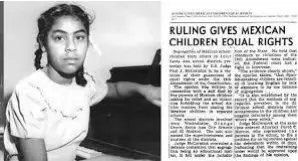- Modules
-
un/HUSH Framework - Lesson Plans & Curricular Resources
-
Resources -
About

Latine Desegregation Lesson Exemplar (Grades 8-12)
Considering your Positionality: Have you considered your own positionality (lens)? How have you considered bias and gaps in your knowledge? What are they and how will you address them before implementing this lesson? What gaps in understanding or information might you have related to the upcoming lesson? Use this space to reflect and self-examine. |
| Use this space to answer the above questions regarding positionality. |
Learning Objective(s) & Resources: State your objectives clearly, ensuring you have considered
all aspects of the un/HUSH framework. What resources or materials do you need to implement
the lesson?
Objectives
Resources - Students
Resources - Teachers |
Anticipatory Set: How are you going to engage your students? Review prior knowledge? Introduce your topic? Organize your lesson for students? Help make content relevant? Ask students to recall previous lessons about Latina/o/e communities:
|
| Elevating Histories: How does your lesson elevate histories, stories and underrepresented histories? |
This lesson elevates histories of various Latina/o/e populations and speaks to the struggle for schooling equity. It also speaks to the history of social movements for Latina/o/e communities, allowing students to see Latina/o/e communities within U.S. history. |
| Representation & Perspective Taking: How does the content meet the needs of all students? Does your lesson provide opportunities for perspective taking and allow students to see themselves? |
Evidence shows that learning about race, ethnicity and gender has positive impacts on all learners. It allows students to see Latina/os as part of our larger communities by seeing them across history. It helps students unpack misunderstandings and misreadings on the population. This lesson allows Latina/os' humanity to be respected and understood by
students, or for students from Latina/o/e communities to see themselves within the
curriculum. It allows teachers to build a more inclusive curriculum. In the facilitated conversations and planned activities (i.e., zine making), students will have
opportunities to collaboratively or privately share their perspectives. |
Engagement: How does the the lesson provide multiple pathways for students to learn the material? For example, will you offer opportunities for small-group learning, discussion, focused practice with precise feedback, or independent work? Yes! Students will work together in groups of two to three to build a zine that speaks to a topic assigned to them. While it is important to understand these historical events in U.S. history, it is crucial that students do not feel compelled to “out” themselves or others. As such, there must be multiple forms of engagement with these materials. Students will have opportunities to share their perspectives privately via journaling (written or recorded). Cost-effective e-technologies will also be used (i.e., Mentimeter) so students can anonymously share their un/learnings about these events with questions posed. Students will also engage in small- and large-group discussions and be encouraged—but not forced—to synthesize their un/learnings with their peers. Lastly, students will enhance their research skills by using primary sources via digital archival materials. |
Expression: How will students demonstrate what they have learned? The creation of many paths is important, as is creativity. Tiered assignments, oral exams, building a model, making a video and using portfolio assessment are examples of the varied demonstration of learning. Students will demonstrate their learning in several ways. Informally (but collectively), they will use Mentimeter to identify key historical events across U.S. history and link them to Latina/o/e communities. Students will also submit a primary source analysis. Primary Source Analysis: Students will write a two-page analysis of a primary source selected from a list of digital archives provided by the teacher or an approved one beforehand. Students should provide a brief summary of the source, incorporate the unit theme and devote time discussing author biases and the importance of such a source to the history of Latina/os in the United States. The assignment will introduce students to critically thinking about primary source research and builds into the final unit project. The primary sources will be incorporated into the final zine the students build. At the end of the unit, students will build on these efforts to create a synthesis project
about the history of Latina/o/e school activism and desegregation. Through this zine project, students will
explain two of the major historical events that occurred and how they potentially impacted the
education of Latina/o/e communities. They will do this as if they were teaching the lesson to someone with
little to no knowledge about these histories. |
Zine Project
During this unit, students will use primary sources, films and visuals to understand the history of Latine communities. Visuals help students learn. As part of the unit grade, students will create a two- to three-page spread (pdf, PPT, Canva.), in groups of two to three, that offers a visual summary of their topic and engagement with primary sources. Students can use text from the class, their own creative interpretation or art, a photo or music. The instructor will combine all of the pages together and create a class zine. Students will then present their pages. Topics to explore:
Things to consider:
Zines can be created via Issuu. |
